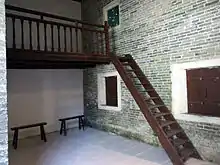Sheung Wo Hang
Sheung Wo Hang[1] is a Hakka village in Sha Tau Kok, in the North District of Hong Kong. It is occupied by members of Hakka Li (李) Clan. Until the 18th century, the village was known as Wo Hang (禾坑).

| Sheung Wo Hang | |||||||||
|---|---|---|---|---|---|---|---|---|---|
| Traditional Chinese | 上禾坑 | ||||||||
| Literal meaning | Upper Wo Hang, with Wo Hang meaning "valley of rice" | ||||||||
| |||||||||


History
Before the arrival of the Lis, Wo Hang was occupied by the Hos (何), the Tsangs (曾) and the Tangs (鄧). Lee Tak-wah (李德華), a member of the Lis, moved to Wo Hang in 1698, shortly after the end of the Great Clearance. Kuen-lam (權林), son of Tak-wah, built an Ancestral Hall in the village. The feng shui of the hall was considered harmful to the Hos, the Tsangs and the Tangs and they left the village.[2] Members of the Li Clan later branched out to found the two nearby villages of Ha Wo Hang ("lower Wo Hang") and Wo Hang Tai Long (禾坑大朗), in around 1730 and 1750 respectively. Wo Hang was subsequently renamed Sheung Wo Hang.[3] Since the 1950s many inhabitants of the village have moved to urban areas in Hong Kong and abroad.[1]
Built heritage
The Kang Yung Study Hall (鏡蓉書屋) was built in the early Qing Dynasty by the Li Clan.[4] The study hall was later converted into a public school, which closed in 1986.[1] It is now a declared monument.
Other historical buildings include:
See also
References
- Antiquities and Monuments Office: Leaflet about the Kang Yung Study Hall
- Historic Building Appraisal: Lee Sze Sai Kui, Entrance Gate, Nos. 86-88 Sheung Wo Hang
- Historic Building Appraisal: Wing Kat Tong, No. 18A Sheung Wo Hang
- "Kang Yung Study Hall, Sha Tau Kok". Antiquities and Monuments Office. Government of Hong Kong. Retrieved 15 October 2013.
- List of the 1,444 Historic Buildings in Building Assessment
External links
| Wikimedia Commons has media related to Sheung Wo Hang. |
- Delineation of area of existing village Sheung Wo Hang (Sha Tau Kok) for election of resident representative (2019 to 2022)
- Antiquities and Monuments Office. Hong Kong Traditional Chinese Architectural Information System. Sheung Wo Hang Tsuen